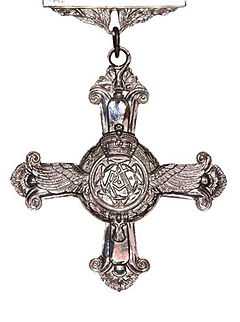Distinguished Flying Cross (United Kingdom)
| Distinguished Flying Cross | |
|---|---|
|
Obverse of the medal. Ribbon: 30mm, diagonal alternate stripes of white and deep purple. | |
| Awarded by United Kingdom and Commonwealth | |
| Type | Military decoration |
| Eligibility | British, Commonwealth, and allied forces |
| Awarded for | ... exemplary gallantry during active operations against the enemy in the air.[1] |
| Status | Currently awarded |
| Statistics | |
| Established | 3 June 1918 |
| Total awarded |
George V: 11,227 George VI: 21,657 Total: 32,884[2] |
| Order of Wear | |
| Next (higher) | Military Cross[3] |
| Next (lower) | Air Force Cross[3] |
| Related | Distinguished Flying Medal |
The Distinguished Flying Cross is the third-level military decoration awarded to personnel of the United Kingdom's Royal Air Force and other services, and formerly to officers of other Commonwealth countries, instituted for "an act or acts of valour, courage or devotion to duty whilst flying in active operations against the enemy".[4]
History
The award was established on 3 June 1918, shortly after the formation of the RAF. It was originally awarded to Royal Air Force commissioned and warrant officers. During World War II it was awarded to Royal Artillery officers serving on attachment to the RAF as pilots-cum-artillery observers. Since World War II, the award has been open to army and naval aviation officers, and since 1993 to other ranks; the Distinguished Flying Medal, awarded to other ranks, has been discontinued. Recipients of the Distinguished Flying Cross are entitled to use the post-nominal letters "DFC". A bar is added to the ribbon for holders of the DFC who received a second award.
During World War I, approximately 1,100 DFCs were awarded, with 70 first bars and 3 second bars. During World War II, 20,354 DFCs were awarded, the most of any award, with approximately 1,550 first bars and 45 second bars.[5] Honorary awards were made on 964 occasions to aircrew from other non-Commonwealth countries.
In 2008 Flight Lieutenant Michelle Goodman became the first woman to receive the DFC.[6][7]
Description
The medal is a cross flory and is 2⅛ inches wide. The horizontal and bottom bars are terminated with bumps, the upper bar with a rose. The medal's face features aeroplane propellers superimposed on the vertical arms of the cross and wings on the horizontal arms. In the centre is a laurel wreath around the RAF monogram surmounted by an Imperial Crown.
The reverse features the Royal Cypher in the centre and the year of issue engraved on the lower arm. The medal is issued named.
The ribbon was originally white with purple broad horizontal stripes, but changed in 1919 to the current white with purple broad diagonal stripes.
The medal was designed by Edward Carter Preston.[8]
| Distinguished Flying Cross ribbon bars | |||
|---|---|---|---|
| DFC | DFC and Bar | DFC and Two Bars | |
| 1918–1919 | |||
| since 1919 | |||
See also
- Category:Recipients of the Distinguished Flying Cross (United Kingdom)
- Commonwealth Realms orders and decorations
- Distinguished Flying Cross (United States)
References
- ↑ "Medals: campaigns, descriptions and eligibility". Ministry of Defence. 12 December 2012. Retrieved 5 February 2015.
- ↑ Mussell, John W. (1 September 2012). Medal Yearbook 2013. Honiton: Token Books. p. 86. ISBN 1908828005. Retrieved 1 December 2013.
- ↑ 3.0 3.1 "JSP 761: Honours and Awards in the Armed Forces" (PDF). Ministry of Defence. December 2014. Retrieved 5 February 2015.
- ↑ The London Gazette: no. 31674. p. 15049. 5 December 1919. Retrieved 5 February 2015.
- ↑ Carter, Nick; Carter, Carol (1998). The Distinguished Flying Cross and How It Was Won. London: Savannah Publications. ISBN 190236600X.
- ↑ The London Gazette: (Supplement) no. 58633. p. 3616. 7 March 2008. Retrieved 11 November 2007.
- ↑ Harris, Paul (8 March 2008). "The brown-eyed, blonde RAF hero who is proud to wear her uniform". The Daily Mail. Retrieved 13 March 2008.
- ↑ Crompton, Ann, ed. (1999). Edward Carter Preston, 1885-1965: Sculptor, Painter, Medallist. Liverpool: University of Liverpool Art Gallery. ISBN 0853237921.
External links
| ||||||||||||||||||||||||||||||||||||||||||||||||||||||||||||
